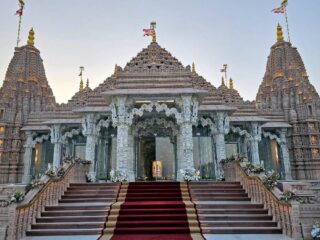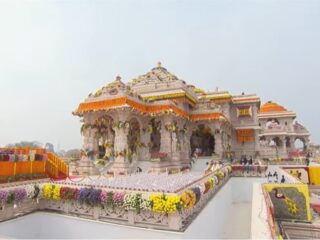By Ms. Ridhima Sharma
(Secular Perspective, August 16-31, 2014)
At a conference at Gujarat University’s Convention Hall on August 2, Supreme Court judge Justice Anil R. Dave commented, “Had I been the dictator of India, I would have introduced the Gita and Mahabharata in Class 1. That is the way you learn how to live life. I am sorry if somebody says I am secular or I am not secular. But we have to get good things from everywhere.”
The statement received strong criticism from the liberal, progressive quarters of the country. The grounds on which the proponents of secularism opposed or expressed their anxiety towards Justice Dave’s view were, however, different. While some were alarmed at the possibility of religious texts gaining currency in and through educational curriculum (though this is obviously not the first time such fears were felt), the others argued that teaching Gita “doesn’t go against Indian secularism. Teaching Gita alone does.” At the heart of this conflict, I believe, lies a greater disagreement- a disagreement on what is truer to the spirit of secularism? Is secularism a religious or anti-religious? Or does it embrace all religions and all forms of religious expression and articulation? Christophe Jaffrelot, for instance, argues, “Far from being a religious, irreligious or anti-religious, this principle (secularism) is on the contrary, perfectly compatible with religiosity. But, recognizing the importance of religion in the public space, the state intervenes in favour of all religious communities. It thus subsidizes all kinds of religious activities, including pilgrimages for Sikhs (to Pakistan) and Hindus (like the one to Amarnath in Jammu and Kashmir). (Jaffrelot 2014). Others argue that religion, inherently and intrinsically, is oppressive in character and one has to step outside the framework of religion to achieve equality. A case in point is Ambedkar’s famous quote, “Inequality is the soul of Hinduism.” For Ambedkar then, discarding the Hindu religion was central to his vision of a democratic, egalitarian ethos.
Whatever be one’s idea of ‘secularism’, the introduction of a text like the Bhagwat Gita in the school curriculum is a suggestion worth being anxious about. This is not just because of the sanctity associated with religious texts but the sheer lack of a critical approach that has come to be characteristic of our education system. And this lack of critical thinking is only likely to be heightened in the case of texts as revered as the Bhagwat Gita. Furthermore, the idea of “getting good things” that Justice Dave made a reference to, needs further probing. Often, hierarchies of caste and gender that are the breeding ground for oppression and discrimination have been glorified as markers of Indian tradition and in fact posited as the only acceptable definition of ‘Indian culture’. If the Bhagwat Gita were to become a classroom textbook, will it be at all open to debate and scrutiny? Or will it be shoved down the throats of children as the sole pills of wisdom and virtue? In a country where ‘religious wisdom’ is supposed to be treasured and elevated to the degree that it is over and above debate or discussion of any kind, the odds of the latter happening are way more. Therefore, the worth of the Gita as a text apart, when placed in context of the pedagogical modes adopted in most schools, the teaching of the Gita comes across as a dangerous proposition.
At this point, it would be useful to understand why teaching of the Gita necessitates a critical attitude in the first place, why it may not be (much to the horror of Justice Dave) the ultimate beacon of inspiration.
While it is true that the Bhagwat Gita is one of the most revered religious books, has been acceptable to people of any different religious denominations and is said to have inspired the likes of Gandhi, Tilak and Aurobindo, it has also been critiqued severely by Ambedkar. Ambedkar’s views on the Gita are found in his unpublished book ‘Revolution and Counter Revolution in Ancient India’.
For Ambedkar, the “Bhagwat Gita is neither a book of religion nor a treatise on philosophy. What the Gita does is to defend certain dogmas of religion on philosophic grounds. It is a philosophic defence of the counter-revolution” (Pandit 1992). He describes the ‘counter-revolution’ as one undertaken by Brahmins to restore and uphold Brahmanism, in response to the moral, social and political revolution caused by Buddhism. He further explains, “This philosophic defence will be found in Chapter 2 verses 2 to 28. The philosophic defence of war offered by the Bhagwat Gita proceeds along two lines of argument. One line of argument is that anyhow the world is perishable and man is mortal. Things are bound to come to an end. Man is bound to die. Why should it make any difference to the wise whether man dies a natural death or whether he is done to death as a result of violence? Life is unreal, why shed tears because it has ceased to be? Death is inevitable, why bother how it has resulted?…Another dogma to which the Bhagwat Gita comes forward to offer a philosophic defence is Chaturvarnya… It offers a philosophic basis to the Chaturvarnya by linking it to the theory of innate, inborn qualities in men… The third dogma for which the Bhagwat Gita offers a philosophic defence is the Karma Marg. By Karma Marg, the Gita means the performance of the observances, such as Yajnas as a way to salvation” (Italics mine).
The reason why I dwell on Ambedkar’s critique of the Bhagwat Gita at length is that these are precisely the kind of voices that are likely to be erased if the Gita were to be taught in the classroom; these are precisely the narratives that will be pushed aside to the margins of what is regarded as ‘knowledge’. The veracity of these opinions aside, the fact that they will not even make it to classroom discussions (or worse, will be villainized) is what is threatening to a democratic and secular fabric. While this is a larger structural problem relating to the ways in which dominant notions of knowledge and history have been constructed and even though, it will not be unique to the teaching of the Gita, it will definitely have far-reaching implications on students’ understanding of their religion and that of ‘others’. So, while Gandhi’s admiration for the Gita will perhaps be included in the syllabus, Ambedkar’s critique of it will most likely be completely sidelined. The reason for this is two-fold: the general importance accorded to Gandhi in the curriculum as opposed to Ambedkar and the intent to posit the Bhagwat Gita as the all-knowing, flawless, ultimate word of authority.
In a similar vein, there have also been feminist commentaries on the Gita. In an oft-quoted passage of the Gita, Arjun, while expressing his fears about fighting the battle, articulates the consequences of untold killing. He is anxious that a state of absolute lawlessness shall prevail and women would deteriorate. What would follow is ‘Kulakshaya’ i.e. diminishing of the clan. The nature of this ‘diminishing’ becomes clearer when he says that the deterioration of women would entail inter-caste marriages and an upheaval of the class and caste structures. What is implied is that inter-caste marriage is one of the most pernicious acts a human being can commit and that it is usually committed as a result of the degradation of women. In addition, women are presented as having no agency of their own and depending on their fathers, husbands and sons at various stages of their lives.
It would not be wrong to argue that ideas such as the above can be used by conservative forces to posit certain notions about what a ‘cultured’ or ‘traditional’ Indian woman is like and to demonize the slightest deviation from these norms.
Thus, one’s biggest fear regarding the introduction of the Gita as part of school curriculum should be the threat that it poses to a vision of equality, democracy and secularism, regardless of what our understanding of ‘secularism’ may be. This is primarily because a religious text of that stature when brought to the classroom is likely to obfuscate all possibilities of a critical discussion and further marginalize voices and narratives that anyway have a history of systematic oppression and discrimination.
(Ms. Ridhima Sharma is a Research Fellow in Centre for Study of
Society and Secularism)
——————————————————
Centre for Study of Society and Secularism
Mumbai.




